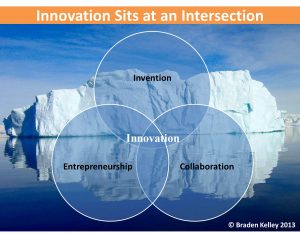 “We need to out-innovate, outeducate, and outbuild the rest of the world”
“We need to out-innovate, outeducate, and outbuild the rest of the world”
– United States President Barack Obama
In the quote above the American President implies that it is somehow the role of the government to drive innovation? But can they? And should they?
Governments and leaders around the world spend a great deal of time talking about innovation and its importance to their economies, but nearly all political leaders and governments have no idea about how to actually foster innovation.
There is a model for how governments can encourage innovation, and boost the performance of their economy as a result, and it is really quite simple. I call it the ICE Model of Innovation, and it’s focused on three key areas where the government can focus its investments of time and money, and both facilitate and fund efforts to advance the public involvement and education deeper into these three areas of ICE:
- Invention
- Collaboration
- Entrepreneurship
1. Invention
 Innovation in any country, especially in the short term, is not achieved by pumping huge sums of money into government-sponsored research and development efforts. Yes, many successful innovations have resulted from government research investments, but we need to take a more strategic approach to these efforts.
Innovation in any country, especially in the short term, is not achieved by pumping huge sums of money into government-sponsored research and development efforts. Yes, many successful innovations have resulted from government research investments, but we need to take a more strategic approach to these efforts.
The Internet itself may be one of the most successful government research and development efforts, and it has served as a platform for an enormous amount of other innovations to build upon. This type of platform innovation is where governments should target their investment dollars. We need more of these types of platform innovation investments, not just spending on basic research. Governments need to think strategically and fund those research efforts that could serve as platform innovations to power a whole new wave of innovative business ideas and job-creating companies in their country.
At the same time governments need to take another look at what they are teaching the children in their country. Let’s face facts. Today’s schools are designed to mass-produce trivia experts and basic competency in reading, writing, and arithmetic (and maybe some history, science, and other important subjects).
But, to succeed in the innovation economy, the next generation is going to need to be proficient in at least these ten things:
- Creativity
- Lateral Thinking
- Problem Solving
- Innovation (of course!)
- Interpersonal Skills
- Collaboration
- Negotiation
- Partnerships
- Entrepreneurship
- And much, much more…
And parents can either pray that the government will revise the curriculum and start focusing more energy on teaching some of these things, or band together and create supplemental learning opportunities for their kids. Seth Godin and I spoke about education and other topics in this interview from 2010:
Some of the work that Dean Kamen is doing with FIRST is a great example of how individuals and non-profits can supplement the educational work of the government to give kids the invention skills and inspiration that they’ll need to help invent a better future.
2. Collaboration
Another important component of innovation is collaboration. People learn more when they connect and share, idea fragments have the opportunity to collect and connect into potentially viable innovation ideas, and are made stronger from additional perspectives and new inputs. In every economy the government has a role to play in helping to encourage collaboration.
Every potential innovation always needs additional human and financial resources to thrive. When done well, the government can help to foster collaboration directly or indirectly. One of my favorite examples of this is the work that NESTA does in the United Kingdom (UK). If you’re not familiar with the organization, it is a charity that was funded by the UK government and NESTA stands for National Endowment for Science Technology and the Arts, and their mission is to help people and organizations bring great ideas to life.
What does Nesta do? Watch the video:
They host a series of innovation, entrepreneurship, science and technology events for citizens of the United Kingdom, produce a collection of complimentary research publications, and are quite active in the social sharing of information (including their own popular blog).
In the United States, the government encourages collaboration through events hosted by the Small Business Administration (SBA) and its public universities around the country to connect scientists, businesspeople and entrepreneurs for collaboration purposes.
And several countries’ efforts to encourage university-business research collaboration is referenced in this report.
3. Entrepreneurship
Everywhere you go cities, states, countries, universities, and private companies are setting up incubators or startup accelerators to encourage entrepreneurship and innovation. This is important, but the importance of entrepreneurship is not limited only to the entrepreneur. At the same time, we must not forget the importance of intrapreneurship to the continuing health of our organizations.
In some ways, intrapreneurship is MORE important to the innovation success of a country than entrepreneurship because collaborative, creative intrapreneurship is the flavor of entrepreneurship that keeps a country’s great companies alive (through this innovation intersection of course).
Entrepreneurs and intrapreneurs are both important and we must consciously try to grow both in a successful society, and while intrapreneurs may not have the same tolerance for risk as an entrepreneur, they also need to understand how to make a business case and other core tenets of entrepreneurship.
There are many government sponsored efforts all around the world to encourage entrepreneurship, including SCORE (Service Corp of Retired Executives), which while technically a charity and not a government entity, received a great deal of support from the SBA in getting started as a national organization and the two entities continue to partner together to encourage, guide, and help entrepreneurs in the United States.
But, the best government programs in the world will still fail to encourage entrepreneurship unless you work to remove the social stigma of failure and examine the penalties for bankruptcy in your country. In countries like the United States and the United Kingdom where bankruptcy penalties are much lower, the level of entrepreneurship is higher. Coincidence?
Conclusion
I hope by now you see that it is possible (but difficult) for governments to encourage innovation IF they focus on increasing the support and skill bases around – invention, collaboration and entrepreneurship. Which countries will have the courage to completely revamp their educational systems to focus on teaching the skills that drive these behaviors? Which countries will create the policies, organizations, events and connections that accelerate these ICE capabilities?
Sources:
Transcript and video of the 2011 State of the Union address
Happy innovating!

![]() Sign up here to get Human-Centered Change & Innovation Weekly delivered to your inbox every week.
Sign up here to get Human-Centered Change & Innovation Weekly delivered to your inbox every week.